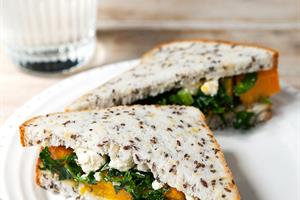

Having or living with someone who has coeliac disease can often provide many expenses you wouldn’t expect. Despite the rise in popularity of gluten free packaged food products over time, they are often far pricier than their regular counterparts, sometimes multiple times the amount.
Why is this? A lot more care has to be taken to ensure that foods are gluten free. Even if a food product does not naturally tend to contain gluten, there is still a chance of cross-contamination in the case of many packaged food products, for example, if the same machinery being used to process foods containing gluten are also used for the gluten free product. The added costs of monitoring processes in order to be labelled Gluten Free, and to be endorsed by the internationally recognised crossed grain logo affect the price of the final product. Some of our members have discussed their concern about the price and composition of gluten free food with us.
Erin Currie describes how as the mother of a coeliac child, she has “concerns over the nutritional value of processed gluten free food...and the cost of standard food such as cereal and bread...let alone treats.” For many coeliacs, particularly in the weeks following diagnosis, the first shop and setting up a GF pantry can be daunting. That’s when the CNZ new member resources can be really helpful. With this in mind, we’ve asked for member tips on how to live gluten free on a budget. While an increased food budget may be somewhat unavoidable, there are a number of ways you can cut down on the costs that a gluten free diet bring.
Raw foods are naturally gluten free, so this is always something to keep in mind. Fruits, vegetables, meats and eggs are all examples of natural foods which provide less hassle than packaged goods. Instead of using bread and pasta, gluten free alternatives like potatoes and rice can be used to provide a source of carbohydrate to meals. Our members also gave advice as to how they cut costs on a coeliac diet. Robyn Moore describes how she uses raw foods to avoid unnecessary costs “It is definitely more expensive to eat gluten free. Then again in some ways...people say ‘you’re so healthy, you’re not eating that’ and I say actually being coeliac forces me to be healthy’. I don’t buy a lot of the pre-made gluten free food because that’s where the costs are.”
Cathy Coldicutt suggests analysing labels to further determine what foods are gluten free: “Anything that’s got gluten free written on it, is often two or three dollars more expensive” so it pays to be able to read nutritional labels, and spot where a product has gluten either by ingredient or with ‘a may contain statement’ in them, for many of these products are ok for most coeliacs to eat even if it doesn’t say gluten free on the front, “and they are often two or three dollars cheaper.”
The ingredient booklet that you receive in your CNZ membership pack lists over 800 ingredients and 300 additives used in New Zealand and Australian foods and indicates whether they are safe for inclusion in a gluten free diet. It’s essential that you become ingredient aware and an expert label reader, and the CNZ community is here to help you. If you need help get in touch with your Area Coordinator who are often more than happy to help out with a supermarket tour to assist you with understanding how to read ingredient labels and choose gluten free brands. It’s also a good idea to plan ahead and buy in bulk for certain food products you know you’ll be using a lot in your meals. It’s also a good idea to freeze and refrigerate any leftover food items quickly, so that you can reuse them and make the best use out of your gluten free meals.
For gluten free products you haven’t tried before it’s always worth looking up reviews online or posting a question on the CNZ blog. There’s nothing worse than buying an expensive product only to find out it isn’t particularly nice and having to deal with either finishing it out of principle or throwing it out and feeling guilty. Even taking all this into account, you may still find this advice somewhat challenging, particularly if you’re a fan of bread and want to have the occasional treat like gluten free chocolate. It may be worth seeing if you’re applicable for a food allowance. For coeliacs, there is the possibility of being eligible for an adult disability allowance (which is income-tested). There is also the children’s disability allowance (not income-tested) and the pharmac subsidy for flour and pasta.
While the added costs of being coeliac are accepted by many as a downside of having the disease, there are methods of living gluten free on a budget. By sticking to natural foods, checking labels, re-using and buying in bulk it is entirely possible to create delicious gluten free meals without breaking the bank. An advantage of committing is that with your newfound knowledge about food and nutrition it's likely that you will be able to stay healthier.